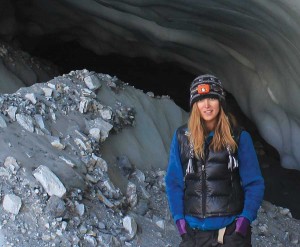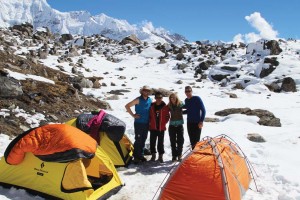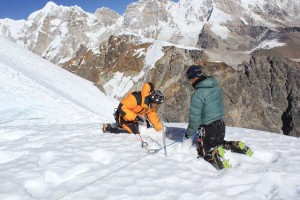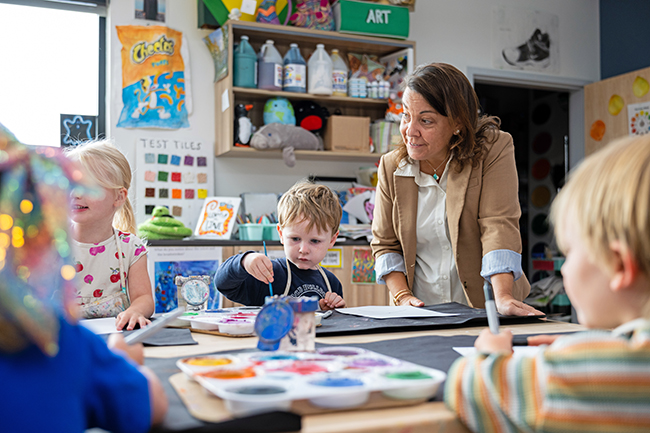Taking Science to New Heights
02 Dec 2014
Geologist works with Sherpas to study polluted mountain snow
By Jane Palmer Photos courtesy Ulyana Horodyskyj (above: Ulyana Horodyskyj is the passenger in an open-cockpit ultralight plane.) When Ulyana Horodyskyj traveled to Nepal for a year, she planned to return with an armful of scientific data and some good memories. She came back with both, but having experienced one tragedy and two accidents, she also came back with a new respect for the mountains and a desire to pass on what she’d learned. “These days, I tread more carefully, but still in pursuit of knowledge that will reveal how our mountains are changing,” says Horodyskyj, 28, a graduate student in geology at the University of Colorado. Horodyskyj (the “j” is silent) went to the Himalayas with the American Climber Science Program—a nonprofit that brings together scientists, climbers and other volunteers to do scientific research in the high mountains of the world—to study the impact of pollution on the snow covering Mount Everest. When dark particles settle on the snow and absorb more solar radiation, the snow melts faster, limiting the amount that can turn to glacier ice and sometimes making avalanches more likely.
The 2013-14 expedition was the second most recent of Horodyskyj’s research trips to the Nepalese mountains; she was there again this fall. She first visited the region in 2011, traveling with a Sherpa field assistant and becoming friendly with many residents of the villages en route to her research site on the Ngozumpa glacier. Those contacts inspired her to form the Sherpa Scientist Initiative, which teaches Sherpas how to take measurements of snow pollution and snow melting, so they can monitor changing conditions on their own treks.
“As a westerner coming to do research in the Himalaya, it was important to me to include the locals,” says Horodyskyj, who speaks “basic” Nepalese. “It’s their land and they stand to lose the most. Understanding the science behind what is happening lessens their fear and promotes action.”
Horodyskyj (the “j” is silent) went to the Himalayas with the American Climber Science Program—a nonprofit that brings together scientists, climbers and other volunteers to do scientific research in the high mountains of the world—to study the impact of pollution on the snow covering Mount Everest. When dark particles settle on the snow and absorb more solar radiation, the snow melts faster, limiting the amount that can turn to glacier ice and sometimes making avalanches more likely.
The 2013-14 expedition was the second most recent of Horodyskyj’s research trips to the Nepalese mountains; she was there again this fall. She first visited the region in 2011, traveling with a Sherpa field assistant and becoming friendly with many residents of the villages en route to her research site on the Ngozumpa glacier. Those contacts inspired her to form the Sherpa Scientist Initiative, which teaches Sherpas how to take measurements of snow pollution and snow melting, so they can monitor changing conditions on their own treks.
“As a westerner coming to do research in the Himalaya, it was important to me to include the locals,” says Horodyskyj, who speaks “basic” Nepalese. “It’s their land and they stand to lose the most. Understanding the science behind what is happening lessens their fear and promotes action.”

Disaster Strikes
Her close friendships with the Sherpas made the April 18, 2014, tragedy even harder to bear. In the early hours of that day, a large ice serac collapsed, sending ice and snow crashing onto Nepali climbers making their way through the treacherous Khumbu icefall on Mount Everest. It killed 16 climbers, including Asman Tamang, a member of Horodyskyj’s expedition. Devastated, Horodyskyj and her team aborted their attempts to set up experiments on Everest and decided to relocate to Himlung, a peak in central Nepal. But there, disaster struck a second time when team member John All fell down a crevasse and sustained severe injuries. Horodyskyj herself didn’t escape accident during her year abroad. In September 2013 she fell from a kayak into the fast-flowing, frigid water pouring from the Ngozumpa glacier’s outflow channel while she was taking measurements. “Even the sight of Boulder Creek makes my blood run cold now as I’m reminded of how I nearly drowned,” she says. Since her return to the U.S. in June, Horodyskyj has struggled with the aftermath of the year, both physically and psychologically. But her enthusiasm for conducting science in the mountains hasn’t dimmed. Over the summer she was an instructor for a “Girls on Ice” program where she taught glaciology and volcanology to high-school girls on Mount Baker, a 10,781-foot glaciated volcano in Washington’s North Cascades. “When I was a teenager, I took part in science camps, and it had a huge impact on me and my career choice,” Horodyskyj says. “So I feel if I have the chance to encourage a girl to pursue science, I should do that—paying it forward.” Horodyskyj returned to Boulder in late August to start analyzing the data she collected over the previous year. Once she has completed her graduate work she plans to continue doing scientific research in extreme places, and she also intends to write books on adventure science for young adults. Although she is still trying to come to terms with the past year’s events, she has plenty of the hoped-for good memories from her expedition.
“Seeing our sirdar [head Sherpa] flash a brilliant smile when the world felt like it was falling apart—that brought joy to my heart,” she says. “Knowing that there are people out there that care for the well-being of others, and the environment, gives me hope that we can still make a difference in this world.”
[divider]
Jane Palmer is a freelance writer and radio producer. She lives in Eldorado Springs with her husband and their daughter.
Horodyskyj returned to Boulder in late August to start analyzing the data she collected over the previous year. Once she has completed her graduate work she plans to continue doing scientific research in extreme places, and she also intends to write books on adventure science for young adults. Although she is still trying to come to terms with the past year’s events, she has plenty of the hoped-for good memories from her expedition.
“Seeing our sirdar [head Sherpa] flash a brilliant smile when the world felt like it was falling apart—that brought joy to my heart,” she says. “Knowing that there are people out there that care for the well-being of others, and the environment, gives me hope that we can still make a difference in this world.”
[divider]
Jane Palmer is a freelance writer and radio producer. She lives in Eldorado Springs with her husband and their daughter. 











